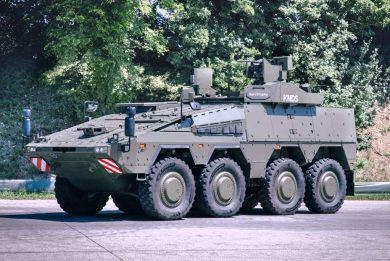
PAS 2025 – KNDS France further details its Mataris loitering munitions portfolio
At IDEX 2025 KNDS France unveiled its family of loitering munitions, named Mataris. Four months later the French arm of KNDS detailed its portfolio in two press conferences, thw first one with representatives of EOS Technologies, the second with those of Delair, the two partner companies specialised in UAVs that developed the Mataris munitions
KNDS is bringing its system integration capacity as well as its’ know how in warheads, while the two UAV manufacturers, EOS Technologie and Delair were providing the platform.

Bigger loitering munitions (LMs) are armed with a 2.5 kg purposely developed warhead, known as Arceus, capable of penetrating an armoured vehicle; it is based on the work done by KNDS on Bonus, the antitank artillery 155 mm ammunition that releases two sensored submunitions that generate each one Explosively Forged Penetrator, EFP in short, which can go through the top armour of a main battle tank. KNDS underlined that the EFP being generated at several dozen meters altitude over the target, cage armour fitted to tanks to protect them from direct hit LMs do not protect them from LMs armed with the Arceus warhead. Not only, this technology allows to use a much smaller quantity of explosive, compared to other solutions, for example shaped charge-based warheads.
As for smaller LMs, a 550 grams warhead was developed; known as MW-FRAG 550G, it is an incendiary/high explosive/fragmentation device fitted with a point detonation fuse, aimed at neutralising infantry, sniper, or antitank positions, as well as unarmoured or lightly armoured vehicles. Putting together those warheads with the relevant flying platforms, gives birth to the Mataris LMs. It is to note that for Western countries, when operating a hard-kill effector, there is always the need to have a man-in-the-loop; the warheads developed by KNDS France are armed by the operator who validates the target before the attack, the two-way data-link allowing not only to see target images provided by on-board sensors in the last phase of the mission, around 1 km from the target, but also to arm the warhead and, should the need arise, to disarm it.

EOS Technologie and KNDS unveiled the MV-100 Veloce 330 at Eurosatory 2024, ablended wing body with a lifting fuselage powered by a jet engine provided by ALM Méca, which ensures a 200 km/h cruise speed and a 400 km/h maximum speed, the airframe front section hosting the Arceus EFP warhead. The full system was demonstrated to the French DGA one week before the Paris Air Show opening, however the French Forces already acquired a first batch of munitions (without warhead) to start experimenting, an iterative development process being in place and every three-four month the industrial team will demonstrate improvements based on lessons learned coming from the military. This process will last at least until year end, when KNDS France and EOS Technologie should be able to freeze the MV-100 development which will then become a finished product, the two companies considering starting the export phase in 2026. “Since yesterday morning [Monday, June 16th, the exhibition opening day], every delegation that came to our booth has been asking questions about LMs,” the speakers said, “and particularly about the MV-100 as not many players have LMs capable to operate at 100 km range.”
Mass production is a key issue when talking about ammunition. “In the initial phase we will be able to produce 100 units per year,” EDR On-Line understanding this is what is usually defined the LRIP, for Low-Rate Initial Production, and this will be the output for 2026. Should the programme get the full green light, the next step will see production growing to 1,000 systems per year, and finally to 1,000 per month.

As said the DGA acquired 23 MV-100 that will be distributed to the forces for experimentation; as the aim is mostly to develop tactics, techniques, and procedures (TTPs), there was no need to have them fitted with the warhead. EDR On-Line understood that off those, 17 are of the MV-100 Veloce 330 type, while 6 are MV-100 Rodeur 330. This has an airframe similar to that of the Veloce 330 but is powered by an internal combustion engine (ICE) that activates a three-blade pushing propeller, maximum take off mass being the same of the Veloce 330, 25 kg. What change considerably are speed and endurance; cruise speed is 120 km/h, while endurance is 8 hours, for a range of around 800 km. The 17 jet powered MV-100s were to be delivered just after the end of the Paris Air Show, while the 6 ICE powered ones will follow in late July; part of the military are already trained, therefore tests will start immediately, EDR On-Line understanding that personnel from the three services will be involved in those tests. Considering the range, these will be flying on shorted distances, with a reduced amount of fuel, actual performances being therefore extrapolated. Operating in GNSS-denied scenarios will of course be one of the tests; not much was said on the solution adopted, a figure of a 1 metre drift every 10 minutes when satellite signal is not available being mentioned, which means 48 metres after an 8-hour flight, sufficiently accurate to allow the operator to find the target through imaging sensors.

Switching to rotary-wing LMs, here KNDS France teamed with Delair, a company specialised in UAVs of that kind which employs around 200 people and has a portfolio ranging from 1 kg to 100 kg drones. The first project jointly developed by KNDS France and Delair was Colibri, the fixed wing light LM based on the Delair UX11 airframe, that carries the 500 grams KNDS warhead at 25 km distance [1], its operational endurance being 40 minutes. The project, launched by the Innovation Defence Agency, saw the two competing teams develop a prototype in one year, then the selected KNDS-Delair team stepped up from prototype to product, now known as MV-25 Oskar, in only six months, the system being now used in Ukraine [2]. The interesting thing is that in the Colibri project, the prime contractor was Delair, while the much bigger KNDS was a subcontractor.

Knowing each other made things easier when the bid for a VTOL LM with a 10 km range was issued [3], this time the two companies working in partnership, KNDS bringing its experience in working with subcontractors, the two companies being complementary in many areas. This gave birth to the MX-10, which is named Damocles. The MX-10 is a quadcopter which has a take-off mass of 3.5 kg, a dimension with rotors running of 800 mm, four spikes carrying the electric motors and rotors being fixed to the central body in a very short time, all structure being in composite materiel. It has the same endurance of the MV-25, 40 minutes, but obviously being the cruise speed much lower the range is limited to 10 km. The prototype was exhibited at Le Bourget in the KNDS stand. “The Damocles is nearing completion, and it will be delivered this summer,” the speakers said, underlining that the system was developed, produced, and qualified in only 12 months, as the team received the development contract in July 2024, “this also thanks to the DGA, and the support of its test centres,” they added. The current production capacity is of 2,000 MT-10 per year, however both KNDS France and Delair are looking forward to considerably increase that capacity.
As for the MT-10, the tube-launched VTOL LM with counter-rotating rotors Kamov-style, this was designed by KNDS France, and for the time being it remains at design level, as long as a customer does not express an interest in that product, which peculiarity will be the capacity to be launched from a tube, which makes it ideal for being integrated in an armoured vehicle.
Photos by P. Valpolini
[1] According to the two companies, Ukrainian operators feedback states that they have reached ranges close to 40 km; these are used mostly for high value targets.
[2] The MV-25 Oskar has not been fully qualified according to French regulations, and is not in service with French Forces, for the time being.
[3] The DGA programme is known in France as MTO-CP, which stands for Munition Téléopérée – Courte Portée, short range loitering munition



